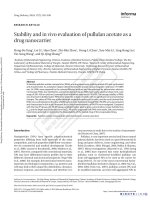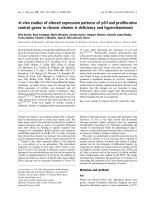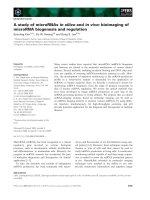In vivo analysis of rhizobacteria and their supernatants for control of charcoal rot of sorghum
Bạn đang xem bản rút gọn của tài liệu. Xem và tải ngay bản đầy đủ của tài liệu tại đây (596.66 KB, 9 trang )
Int.J.Curr.Microbiol.App.Sci (2019) 8(9): 88-96
International Journal of Current Microbiology and Applied Sciences
ISSN: 2319-7706 Volume 8 Number 09 (2019)
Journal homepage:
Original Research Article
/>
In vivo Analysis of Rhizobacteria and their Supernatants for Control of
Charcoal Rot of Sorghum
Vinayaka A. Bannur1*, S.N. Chattannavar1 and P.U. Krishnaraj2
1
Plant Pathology, All India Coordinated Sorghum Improvement Project,
MARS, Dharwad, India
2
Agricultural Microbiology, University of Agricultural Sciences Dharwad – 580 005,
Karnataka, India
*Corresponding author
ABSTRACT
Keywords
Charcoal rot,
Macrophomina
phaseolina,
Rhizobacteria,
Supernatants
Article Info
Accepted:
04 August 2019
Available Online:
10 September 2019
Charcoal rot of sorghum caused by Macrophomina phaseolina is a disease of
economic importance for which a high level of genetic resistance is not
available. Therefore, an effort was made to manage this disease with potent
rhizobacterial strains viz., AUDP 139 and AUDT 801 in CSV 8R and CSV
29R cultivars. In CSV 8R, seed soaked in supernatants of AUDP 139 for two
hours recorded least charcoal rot incidence of 40.58 % with highest yield of
1924.90 Kg/ha whereas in CSV 29R, seed treatment with AUDT 801 + AUDP
139 @ 3g/Kg of seeds recorded least disease incidence of 14.23 % with
highest yield of 2675.73 Kg/ha. It is inferred that the use of selection of
effective strains of rhizobacteria can be a useful component of integrated
management of charcoal rot in sorghum.
hectares of which 1.16 lakh hectares in Kharif
and 9.74 lakh hectares in rabi with production
and productivity of 11.50 lakh tons and 1,052
kg ha-1 respectively (Anon., 2017).
Introduction
Sorghum bicolor (L.) Moench commonly
known as "Jowar" is one of the most important
millets of India belonging to the family
"Poaceae". The major sorghum cultivating
states are Maharashtra, Karnataka, Rajasthan,
Tamil Nadu and Andhra Pradesh. It is being
grown in two seasons: kharif season as a
rainfed crop while in rabi season under
remaining soil moisture conditions. In
Karnataka, it is cultivated on 10.90 lakh
Charcoal rot caused by Macrophomina
phaseolina (Tassi) Goid. is major disease
among biotic stresses in post rainy season and
it cause major losses in grain and fodder yield.
In India, almost all the cultivated hybrids and
varieties are susceptible to charcoal rot
(Jahagirdar, 2007). Charcoal rot pathogen, M.
88
Int.J.Curr.Microbiol.App.Sci (2019) 8(9): 88-96
phaseolina causes 100 per cent lodging and
significant yield losses up to 64 per cent in
India under post-rainy conditions in sorghum
(Mughogho and Pande, 1984). The disease is
well characterized by poor grain filling,
premature leaf senescence and crop lodging.
Internally, the stem pith of infected plants
become disintegrated and the separated
fibrovascular bundles are covered with the
small black sclerotial bodies of the fungus
which give the stem a blackened appearance,
hence the name charcoal rot.
does not harm the environment and their
application is sustainable in long run.
Materials and Methods
A field experiment on integrated disease
management was laid out in charcoal rot sick
plot at MARS, Dharwad in medium deep
black soil having 45 - 60 cm soil depth during
rabi season of 2018-19.
Biological control can be viewed as an
alternative and safe method to control this
disease as it also has additional benefit of
plant
growth-promotion
(PGP)
traits
(Labuschangne et al., 2010).
This trial was laid out in randomized block
design (RBD) with three replications with a
net plot size of 3.15 x 4.2 m2 and sown on
second fortnight of October with a spacing of
45×15cm using CSV 8R (highly susceptible
for charcoal rot) and CSV 29R (moderately
resistant for charcoal rot) genotypes.
Plant disease management by plant growth
promoting rhizobacteria (PGPR) is one of the
most effective and eco-friendly approach
compared to conventional chemical control
methods, and PGPRs as biocontrol agents
possess certain advantages, because PGPR
AUDT 801 and AUDP 139 rhizobacterial
isolates which found superior in in vitro along
with reference isolate of Trichoderma
harzianum were evaluated under field
conditions for their efficacy to control
charcoal rot.
Treatment Details
Treatments
T1
T2
T3
T4
T5
T6
T7
T8
T9
T10
Description
AUDT 801 @ 3g/Kg of seeds
AUDT 801 @ 4g/Kg of seeds
AUDP 139 @ 3g/Kg of seeds
AUDP 139 @ 4g/Kg of seeds
AUDT 801+AUDP 139 @ 3g/Kg of seeds
AUDT 801+AUDP 139 @ 4g/Kg of seeds
Seed soaking in supernatants of AUDT 801 for 2 hours
Seed soaking in supernatants of AUDP 139 for 2 hours
Trichoderma harzianum @ 4g/Kg of seeds
Control
Note: AUDT = Agricultural University Dharwad Actinobacteria and AUDP = Agricultural University Dharwad
Pseudomonas.
Incidence of charcoal rot was recorded at crop
maturity (115 days after emergence).
knife for ensuring the presence or absence of
charcoal rot symptoms. Percentage incidence
of charcoal rot was calculated for each plot.
Observations on charcoal rot parameters and
yield related parameters were recorded.
Each plant in a plot was split open
longitudinally along with the roots with a
89
Int.J.Curr.Microbiol.App.Sci (2019) 8(9): 88-96
the least mean nodes crossed (2.40) and was
on par with all the treatments except T7.
However, there was significant difference
among the treatments as compared to control.
The highest mean nodes crossed recorded in
control (3.33).
Results and Discussion
Charcoal rot percentage
In CSV 8R, seed soaking in supernatants of
AUDP 139 for two hours (T8) recorded the
least charcoal rot percentage (40.58 %) with
highest per cent disease reduction over control
(30.14 %) and was on par with other
treatments. However, significant differences
were observed in all the treatments when
compared with the control (58.09 %).
In CSV 29R, seeds treated with AUDT 801 @
3 g/kg of seeds (T1) recorded the least mean
nodes crossed (2.06) and was on par with all
the treatments. However, there was significant
difference among the treatments as compared
to control. The highest mean nodes crossed
recorded were in control (2.73). The mean
nodes crossed varied from 2.40 to 3.33 and
2.06 to 2.73 in CSV 8R and CSV 29R
respectively.
In CSV 29R cultivar, the least charcoal rot
incidence (14.23 %) was found in seeds
treated with AUDT 801 + AUDP 139 @ 3
g/kg of seeds (T5) with highest per cent
disease reduction over control (45.45 %) and
was on par with all other treatments. However,
significant differences were observed in all the
treatments as compared to control (26.09 %).
In CSV 8R, charcoal rot percentage varied
from 40.58 to 58.09 % whereas in CSV 29R
cultivar it ranged from 15.85 to 26.09 %. So, it
was confirmed that CSV 29R recorded least
incidence of charcoal rot compared to CSV
8R.
In pooled analysis, it was observed that the
seeds treated with AUDT 801 @ 3 g/kg of
seeds (T1) recorded the least mean nodes
crossed (2.26) and was on par with all the
treatments followed by the seeds treated with
AUDT 801 + AUDP 139 @ 3 g/kg of seeds
(T5) and seeds treated with T. harzianum @ 4
g/kg of seeds (T9) which recorded 2.36. The
maximum mean nodes crossed recorded in
control (3.03) (Table 1).
In pooled analysis, it was found that seed
soaking in supernatants of AUDP 139 for two
hours (T8) recorded the least charcoal rot
percentage (28.21 %) and was on par with all
the treatments followed by seeds treated with
AUDT 801 + AUDP 139 @ 3 g/kg of seeds
(T5) which recorded 28.36 charcoal rot
percentage. The highest pooled per cent
disease reduction over control was recorded in
seeds treated with AUDT 801 + AUDP 139 @
3 g/kg of seeds (36.14 %) (T5) and the
maximum charcoal rot percentage was noticed
in control (42.09 %) (Table 1, Fig. 1 and Plate
2).
Mean Length of Spread (MLS)
In CSV 8R, seeds treated with AUDT 801 +
AUDP 139 @ 3 g/kg of seeds (T5) recorded
the least mean length of spread (25.20 cm) and
was on par with T9, T1, T3, T6 and T2. All the
treatments varied significantly to control. The
highest mean length of infection was observed
in control (38.60 cm).
In CSV 29R, seeds treated with T. harzianum
@ 4 g/kg of seeds (T9) recorded the least mean
length of spread of 25.20 cm and was on par
with all the treatments except T5. All
treatments except T5 varied significantly to
control. The highest mean length of infection
was observed in control (32.53 cm).
Mean Nodes Crossed (MNC)
In CSV 8R, seeds treated with AUDT 801 +
AUDP 139 @ 3 g/kg of seeds (T5) recorded
90
Int.J.Curr.Microbiol.App.Sci (2019) 8(9): 88-96
The mean length of spread ranged from 25.20
cm to 38.60 cm and 25.20 cm to 32.53 cm in
CSV 8R and CSV 29R respectively.
highest per cent increase in grain yield over
control (21.27 %) followed by seeds treated
with AUDP 139 @ 3 g/kg of seeds (T3)
(2183.16 kg/ha). The lowest grain yield was
observed in control (1802.71 kg/ha) (Table 2
and Fig. 2).
Pooled analysis revealed that, seed treatment
with T. harzianum @ 4 g/kg of seeds (T9)
recorded the least mean length of spread
(26.76 cm) and was on par with all treatments.
The maximum mean length of spread was
observed in control (35.56 cm) (Table 1).
Fodder yield
In CSV 8R, the highest fodder yield was
observed in seed soaking in supernatants of
AUDP 139 for two hours (T8) (2.92 t/ha) and
was on par with other treatments. The least
fodder yield was recorded in control (2.54
t/ha).
Grain yield
In case of CSV 8R, grain yield per hectare
differed significantly among the treatments.
The highest grain yield was recorded in seed
soaking in supernatants of AUDP 139 for two
hours (T8) (1924.90 kg/ha) with highest per
cent increase in grain yield over control (20.69
%) followed by seeds treated with T.
harzianum @ 4 g/kg of seeds (T9) (1902.22
kg/ha). The lowest grain yield was recorded in
control (1594.85 kg/ha).
In CSV 29R, the highest fodder yield was
recorded in seeds treated with AUDT 801 +
AUDP 139 @ 3 g/kg of seeds (T5) (5.23 t/ha)
and was on par with other treatments. The
least fodder yield was observed in control
(4.04 t/ha).
The fodder yield ranged from 2.54 to 2.92 t/ha
and 4.04 to 5.23 t/ha in CSV 8R and CSV 29R
respectively.
In CSV 29R, grain yield per hectare differed
significantly among the treatments. The
highest grain yield was recorded in seeds
treated with AUDT 801 + AUDP 139 @ 3
g/kg of seeds (T5) (2675.73 kg/ha) with
highest per cent increase in grain yield over
control (33.08 %) followed by seeds treated
with AUDP 139 @ 3 g/kg of seeds (T3)
(2637.94 kg/ha). The lowest grain yield was
recorded in control (2010.57 kg/ha).
Pooled analysis revealed that maximum
fodder yield was recorded in seeds treated
with AUDT 801 + AUDP 139 @ 3 g/kg of
seeds (T5) (3.97 t/ha) followed by seeds
treated with AUDP 139 @ 4 g/kg of seeds (T4)
(3.93 t/ha).
The least fodder yield was recorded in control
plants (3.20 t/ha) (Table 2).
The grain yield ranged from 1594.85 to
1924.20 kg/ha and 2010.57 to 2675.73 kg/ha
in CSV 8R and CSV 29R respectively.
Hundred seed weight
Pooled analysis revealed that grain yield per
hectare varied significantly among the
treatments.
In case of hundred seed weight there were no
significant differences among the treatments
in both the cultivars. However, in CSV 8R the
highest hundred seed weight was observed in
seeds treated with AUDT 801 + AUDP 139 @
3 g/kg of seeds (T5) (2.74 g) and the lowest
was noticed in control (2.35 g).
The maximum grain yield was observed in
seeds treated with AUDT 801 + AUDP 139 @
3 g/kg of seeds (T5) (2210.87 kg/ha) with
91
Int.J.Curr.Microbiol.App.Sci (2019) 8(9): 88-96
Table.1 Management of charcoal rot of sorghum in field conditions (charcoal rot parameters)
Treatments
T1
T2
T3
T4
T5
T6
T7
T8
T9
T10
Treatment Details
AUDT 801 @ 3g/kg of
seeds
AUDT 801 @ 4 g/kg of
seeds
AUDP 139 @ 3g/kg of seeds
AUDP 139 @ 4 g/kg of
seeds
AUDT 801+AUDP 139 @
3g/kg of seeds
AUDT 801+AUDP 139 @ 4
g/kg of seeds
Seed soaking in supernatants
of AUDT 801 for two hours
Seed soaking in supernatants
of AUDP 139 for two hours
Trichoderma harzianum @ 4
g/kg of seeds
Control
S.Em. ±
CD @ 5%
CV (%)
CSV 8R
Per cent
disease
reductio
n over
control
44.83
(41.97)*
44.72
(41.85)
43.65
(41.30)
47.89
(43.78)
42.50
(40.67)
49.25
(44.57)
48.76
(44.28)
40.58
(39.39)
42.26
(40.41)
58.09
(49.77)
2.73
8.13
11.06
22.82
23.01
24.85
17.55
26.83
15.21
16.06
30.14
27.25
-
Charcoal rot (%)
CSV29R Per cent
disease
reductio
n over
control
17.74
(24.86)
18.54
(25.45)
15.91
(23.26)
18.05
(25.14)
14.23
(22.08)
16.90
(24.27)
18.11
(25.17)
15.85
(23.14)
20.97
(27.19)
26.09
(30.17)
1.32
3.95
9.16
32.00
28.93
39.01
30.81
45.45
35.22
30.58
39.24
19.62
-
* Arc sine values
92
Pooled
charcoal
rot (%)
31.28
(33.41)
31.63
(33.65)
29.78
(32.28)
32.97
(34.46)
28.36
(31.37)
33.07
(34.42)
33.43
(34.72)
28.21
(31.26)
31.61
(33.80)
42.09
(39.97)
2.02
6.04
10.11
Mean nodes crossed (No.)
CSV
CSV
Pooled
8R
29R
Mean length of infection (cm)
CSV
CSV
Pooled
8R
29R
2.46
2.06
2.26
28.20
26.54
27.37
25.97
2.63
2.33
2.48
30.33
26.07
28.20
31.93
2.66
2.46
2.56
30.06
27.80
28.93
24.18
2.60
2.26
2.43
31.06
28.71
29.88
36.14
2.40
2.33
2.36
25.20
29.40
27.30
25.21
2.53
2.46
2.49
30.26
26.20
28.23
23.32
2.76
2.20
2.48
31.20
28.23
29.71
34.69
2.68
2.26
2.47
32.40
27.58
29.99
23.43
2.60
2.13
2.36
28.33
25.20
26.76
-
3.33
2.73
3.03
38.60
32.53
35.56
0.10
0.32
7.08
0.13
0.41
10.27
0.11
0.36
8.67
1.89
5.64
10.76
1.24
3.69
7.74
1.56
4.67
9.25
Pooled
per cent
disease
reductio
n over
control
27.41
Int.J.Curr.Microbiol.App.Sci (2019) 8(9): 88-96
Table.2 Management of charcoal rot of sorghum in field conditions (yield parameters)
Treatments
Treatment Details
CSV 8R
Per cent
increase in
grain yield
over
control
Grain Yield (kg/ha)
CSV 29R
Per cent
increase in
grain yield
over
control
Pooled
grain
yield
Pooled per
cent
increase in
grain yield
over control
Fodder Yield (t/ha)
CSV 8R
CSV
Pooled
29R
100 seed weight (gms)
CSV
CSV
Pooled
8R
29R
T1
AUDT 801 @ 3g/kg of seeds
1655.32
3.79
2151.67
7.01
1903.49
5.40
2.76
4.92
3.84
2.58
2.83
2.70
T2
AUDT 801 @ 4 g/kg of seeds
1743.51
9.32
2136.55
6.26
1940.03
7.79
2.81
4.92
3.86
2.46
2.74
2.60
T3
AUDP 139 @ 3g/kg of seeds
1728.39
8.37
2637.94
31.20
2183.16
19.78
2.82
5.03
3.92
2.66
2.72
2.69
T4
AUDP 139 @ 4 g/kg of seeds
1693.11
6.16
2207.10
9.77
1950.10
7.96
2.75
5.11
3.93
2.42
2.73
2.57
T5
AUDT 801+AUDP 139 @
3g/kg of seeds
1746.02
9.47
2675.73
33.08
2210.87
21.27
2.71
5.23
3.97
2.74
3.10
2.92
T6
AUDP 801+AUDP 139 @ 4
g/kg of seeds
1690.59
6.00
2214.66
10.15
1952.62
8.07
2.69
4.83
3.76
2.63
2.85
2.74
T7
Seed soaking in supernatants
of AUDT 801 for two hours
1602.38
0.47
2249.95
11.90
1926.16
6.19
2.74
4.77
3.75
2.64
2.88
2.76
T8
Seed soaking in supernatants
of AUDP 139 for two hours
1924.90
20.69
2393.54
19.04
2159.22
19.86
2.92
4.56
3.74
2.54
2.81
2.67
T9
Trichoderma harzianum @ 4
g/kg of seeds
1902.22
19.27
2182.42
8.54
2042.32
13.90
2.86
4.71
3.78
2.55
2.93
2.74
T10
Control
1594.85
-
2010.57
-
1802.71
1.94
3.60
2.77
2.35
2.61
2.48
S. Em. ±
0.14
0.34
0.24
0.15
0.32
0.23
0.08
0.10
0.09
CD @ 5%
0.41
1.01
0.71
0.46
0.95
0.70
0.26
0.30
0.28
CV (%)
10.65
19.47
15.06
9.85
11.51
10.68
6.01
6.28
6.14
93
Int.J.Curr.Microbiol.App.Sci (2019) 8(9): 88-96
Fig.1 Management of charcoal rot of sorghum (Per cent charcoal rot)
Fig.2 Management of charcoal rot of sorghum (yield)
94
Int.J.Curr.Microbiol.App.Sci (2019) 8(9): 88-96
Plate.1 Lodging of the crop
CSV 8R
CSV 29R
Plate.2 Effective treatments for charcoal rot
T8
Control
Control
In CSV 29R, the highest hundred seed weight
was recorded in seeds treated with AUDT 801
+ AUDP 139 @ 3 g/kg of seeds (T5) (3.10 g)
and the lowest was observed in control (2.61
g).
T5
seed weight was recorded in AUDT 801 +
AUDP 139 @ 3 g/kg of seeds (T5) (2.92 g)
followed by seed soaking in supernatants for
two hours for AUDT 801 (T7) (2.76 g). The
lowest hundred seed weight was recorded in
control (2.48 g) (Table 2).
Pooled analysis revealed that there were no
significant differences among the treatments
as they were on par with each other.
However, numerically the highest hundred
It is inferred that the treatment AUDT 801 +
AUDP 139 @ 3 g/kg of seeds (T5) was found
better for reducing the charcoal rot
95
Int.J.Curr.Microbiol.App.Sci (2019) 8(9): 88-96
percentage, increasing both grain yield and
fodder yield along with increase in test weight
i.e., hundred seed weight.
Govt. of India, New Delhi, pp. 97-99.
Das, I. K., Indira, S., Annapurna, A.,
Prabhakar and Seetharama, N., 2008,
Bio control of charcoal rot in sorghum
by
fluorescent
pseudomonads
associated with the rhizosphere. Crop
Prot., 27: 1407–1414.
Imran, A. S. and Shaukat, S. S., 2002,
Mixtures of plant disease suppressive
bacteria enhance biological control of
multiple tomato pathogens. Biol. Fertil.
Soils, 36: 260-268.
Jahagirdar, S., 2007, Present status and future
research needs on the management of
charcoal rot of sorghum. Agric. Rev.,
28(3): 197-206.
Labuschagne, N., Pretorius, T. and Idris, A.
H., 2010, Plant growth promoting
rhizobacteria as biocontrol agents
against soil borne plant diseases.
Academia, 1-13.
Mughogho, L. K. and Pande, S., 1984,
Charcoal rot of sorghum. In: Sorghum
Root and Stalk Rots, Critical Review.
Proceedings of Consultative Group
Discussion of Research on Enemies and
Strategies for Control of Sorghum Root
and Stalk Rot Diseases, 27 November 2 December, 1983, Bellagio, Italy,
ICRISAT, Patancheru, Andhra Pradesh,
India, pp. 11-24.
The results thus obtained support the similar
work done by Das et al., (2008) who reported
that among three different Pseudomonas
chlororaphis strains viz., SRB 127, SRB 129
and SRB 288, Pseudomonas chlororaphis
SRB 127 was the most efficient in control of
charcoal rot of sorghum. Effective
colonization and survival in sorghum
rhizosphere, production of extracellular
antibiotic and different metabolites with
antagonistic properties, volatile substances
like hydrogen cyanide (HCN) and siderophore
production which limit the iron concentration
for pathogen together contributed to the
disease control. Combined application of
AUDP 139 and AUDT 801 resulted in
synergistic effect on suppression of charcoal
rot and enhanced test weight. Similar findings
in synergism was earlier reported by Imran
and Shaukat (2002) in control of root rot by
M. phaseolina in tomato.
References
Anonymous., 2017, Selected state/seasonwise area, production and productivity
of jowar in India. Ministry of
Agriculture and Farmers’ Welfare,
How to cite this article:
Vinayaka A. Bannur, S.N. Chattannavar and Krishnaraj, P.U. 2019. In vivo Analysis of
Rhizobacteria and their Supernatants for Control of Charcoal Rot of Sorghum.
Int.J.Curr.Microbiol.App.Sci. 8(09): 88-96. doi: />
96









